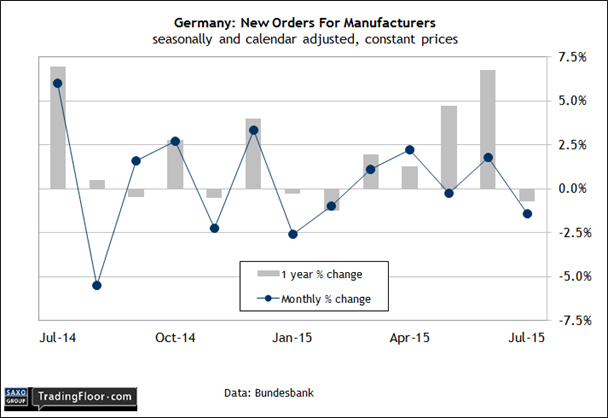- German factory orders should bounce back in today’s August report
- Soft US data may be keeping the EURUSD trapped in a trading range
- The drop in Treasury yields means the odds for a Fed hike this year are low to nil
Tuesday’s a quiet day for economic releases. The main event for Europe is Germany’s monthly report on factory orders. Meanwhile, in the wake of weaker-than-expected economic data for the US, keep an eye on EUR/USD and the 2-year Treasury yield for clues on the crowd’s expectations for this year's endgame.
Germany: Factory Orders (0600 GMT): Is Europe’s largest economy facing another round of macro challenges? The combination of slowing growth in China and emerging markets generally plus last month’s emissions scandal at Volkswagen (XETRA:VOWG), (OTC:VLKPY), are raising new questions about Germany’s economic outlook. Adding to the potential for trouble is the return of deflation in Europe’s year-over-year numbers – headline consumer prices dipped 0.1% in September vs. the year-earlier level.
“The global outlook has deteriorated and this won’t help investment spending,” an economist at the Frankfurt office of Deutsche Bank told Bloomberg.
Maybe so, but the crowd is expecting that today’s August data on manufacturers’ orders in Germany will post a solid rebound after July’s retreat. Econoday.com’s consensus forecast sees orders rising 0.4% in August over the previous month. The annual comparison is on track for an even stronger revival: orders are expected to jump 5.7% over the year-earlier level.
Berenberg is also optimistic that Germany can weather the latest challenges. “Can the Eurozone recovery stay on track despite these external shocks?” the bank asked last week. “Yes it can, probably with no more than a modest dent in growth in the next two quarters.”
The case for optimism will look a bit more convincing if today’s update on factory orders matches the crowd’s upbeat projections.

EUR/USD: The European Central Bank last month pared its outlook for GDP growth in the Eurozone. The September estimate ticked down 10 basis points to an expected 1.5% rise for 2015. Next year’s estimate was clipped a bit more, falling 20 basis points to just 1.9%. Although “domestic dynamics should eventually strengthen,” the ECB reasoned, the case for anticipating stronger numbers rests primarily on hope rather than hard data at the moment.
Growth also ticked lower for the currency union last month according to the Eurozone Composite Purchasing Managers’ Index (PMI). The September reading for the headline data slipped to 53.6 from 54.3 in the previous month – a four-month low. Although that still equates with a moderate expansion, “the weakening of the pace of expansion in September raises the risk of growth fading further in the fourth quarter, which would in turn boost the likelihood of the ECB opening the QE taps further,” noted Markit’s chief economist.
If a deeper round of monetary stimulus in Europe is near, the change implies a weaker euro. Or does it? The EURUSD has been in a relatively tight trading range in recent weeks – roughly 1.115 to 1.130. But with concerns that the US economy may be slowing by more than just a little, the appetite is soft at the moment for selling euros and buying greenbacks. That could change, of course, if US data perks up. But for the moment, the blowback from last week’s surprisingly weak report on payrolls in September suggests that America’s growth trend is decelerating.
The Eurozone data is hardly inspiring either, but the focus for now is on the US. forex traders will be looking for signs that America’s economy isn’t as weak as the latest jobs data implies – news that could spark a new phase of dollar strength. If that turns out to be a lost cause, the prospects for a EURUSD rally appear limited.

U.S. 2-Year Treasury Yield: It’s not clear that the US economy is strong enough to weather a series of rate hikes any time soon, advised former Fed chairman Ben Bernanke on Monday. The 2-year Treasury yield – considered the most sensitive spot on the yield curve for rate expectations – seems to agree.
After jumping to over 0.8% in mid-September – a four-year high – the 2-year yield has fallen back to around 0.6% in recent sessions. The catalyst? Softer-than-expected economic data, including the weak gain in nonfarm payrolls in September.
Macro expectations have eased, but Eric Rosengren, president of the Boston Fed, still thinks the central bank could start rising interest rates before the year’s out. Doesn’t the sluggish rise in payrolls in September gut the case for squeezing monetary policy this year? Maybe, but it’s still not off the table, he explained via Reuters:
"We need to understand whether [it] was an anomaly or whether it was symptomatic of greater weakness in the economy than we were expecting. One report alone doesn't tell us that, so we'll have to see the incoming data."
Is that a reason why the 2-year yield is showing signs of stabilising around the 0.6% mark while the market awaits more data? Maybe, although another leg down for yields at this stage would send a strong clue that the crowd has abandoned the idea that a Fed hike in 2015 is possible.

Disclosure: Originally published at Saxo Bank TradingFloor.com
